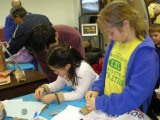Focus on What Works, Not What Doesn’t
 Recently, I became acquainted with “Appreciative Inquiry” — a positive change theory from the field of Organizational Development. In a nutshell, this theory suggests that an organization that inquires into problems will continue to discover more of the same, while an organization that strives to appreciate what is best in itself (and others) will discover more and more of what is good.
Recently, I became acquainted with “Appreciative Inquiry” — a positive change theory from the field of Organizational Development. In a nutshell, this theory suggests that an organization that inquires into problems will continue to discover more of the same, while an organization that strives to appreciate what is best in itself (and others) will discover more and more of what is good.
This theory affirms what my intuition has always told me — that the best way to get where you want to be is to look at how others have successfully done so.
For instance, in my desire to run IWITTS effectively, I have participated in several courses and some coaching for non-profit executive directors. I learned best practices for running the business-side of IWITTS and I implemented them. On a personal level, when I wanted to lose weight a few years ago, I joined WeightWatchers. After learning what worked from the leader and other participants, I lost a size and changed my lifestyle.
I think most people would agree that the best way to learn something new is to focus on positive models. Why then, do many of those in the diversity community focus on what’s not working rather than what is as their primary strategy to effect change?
For example, many workshops and publications on recruiting and retaining women in STEM (Science, Technology, Engineering and Math) focus on the barriers women and girls face with very little information on how to overcome them — the ratio is usually 90% barriers, 10% solutions. I’ve noticed that many of those working on diversity issues seem most animated when describing the “wrongs” committed by offending parties. This, I fear, may create a culture of victimhood among equity practitioners that does not promote change. Don’t get me wrong, it is critical to understand barriers and discover what has not worked; however, if the goal is to bring about positive results, focusing on the negative can be counter-productive.
I get much more energized when I hear about strategies that have worked — whether it’s for personal issues, such as losing weight, or for professional challenges, such as recruiting and retaining women to STEM. Sure, at WeightWatchers we talked about “food pushers” who insist on heaping food on our plate, but in the next sentence we learned how to resist them. That’s also true of the WomenTech Training I designed. Ninety-five percent of it focuses on positive solutions. And for every barrier discussed, a research-based solution(s) is proposed. Over the past 15 years, we have collected evaluations of every IWITTS training, and a recurrent theme among participants is that our workshop provides practical solutions that can be implemented right away.
All in all, I think the field of diversity needs to make a shift — to have a primary focus on the positive and what works rather than what doesn’t. What do you think?

 One of our
One of our 


 I had the good fortune of seeing the movie Julie and Julia this past weekend and I loved it, as did the rest of the audience! Everyone clapped after many of the scenes—something which rarely happens in the movies. The movie is based on the true stories of the famous, American-French chef Julia Child (played by Meryl Streep) and a New York writer named Julie who decides to cook all of Julia’s recipes in a year and to blog about it daily.
I had the good fortune of seeing the movie Julie and Julia this past weekend and I loved it, as did the rest of the audience! Everyone clapped after many of the scenes—something which rarely happens in the movies. The movie is based on the true stories of the famous, American-French chef Julia Child (played by Meryl Streep) and a New York writer named Julie who decides to cook all of Julia’s recipes in a year and to blog about it daily. Have a question on recruiting and retaining women and girls in technology that you want to ask me? Now’s your chance, today I am launching a “Dear Donna” advice column except it will be about gender equity questions. Send your questions to me via
Have a question on recruiting and retaining women and girls in technology that you want to ask me? Now’s your chance, today I am launching a “Dear Donna” advice column except it will be about gender equity questions. Send your questions to me via




Recent Comments